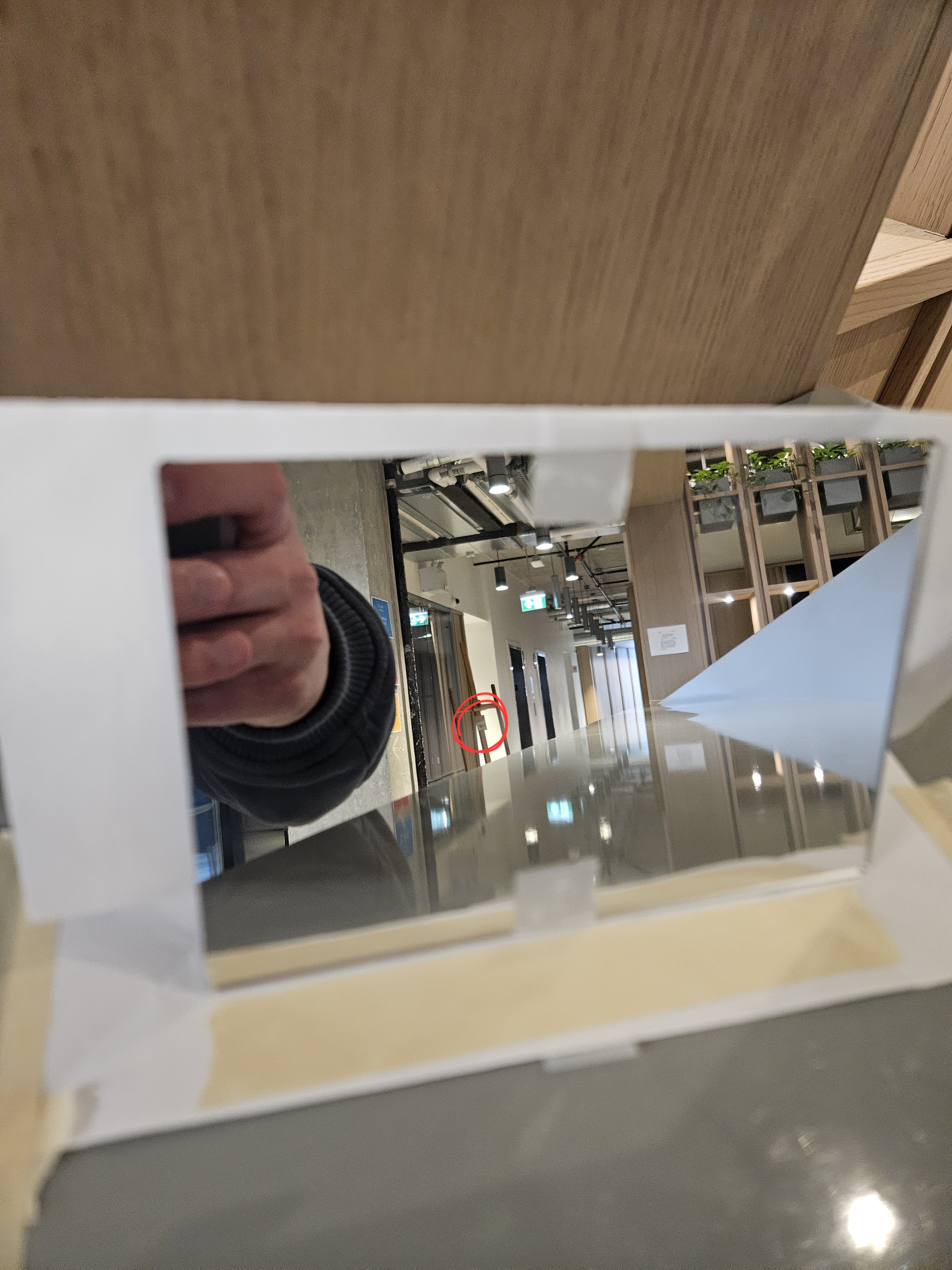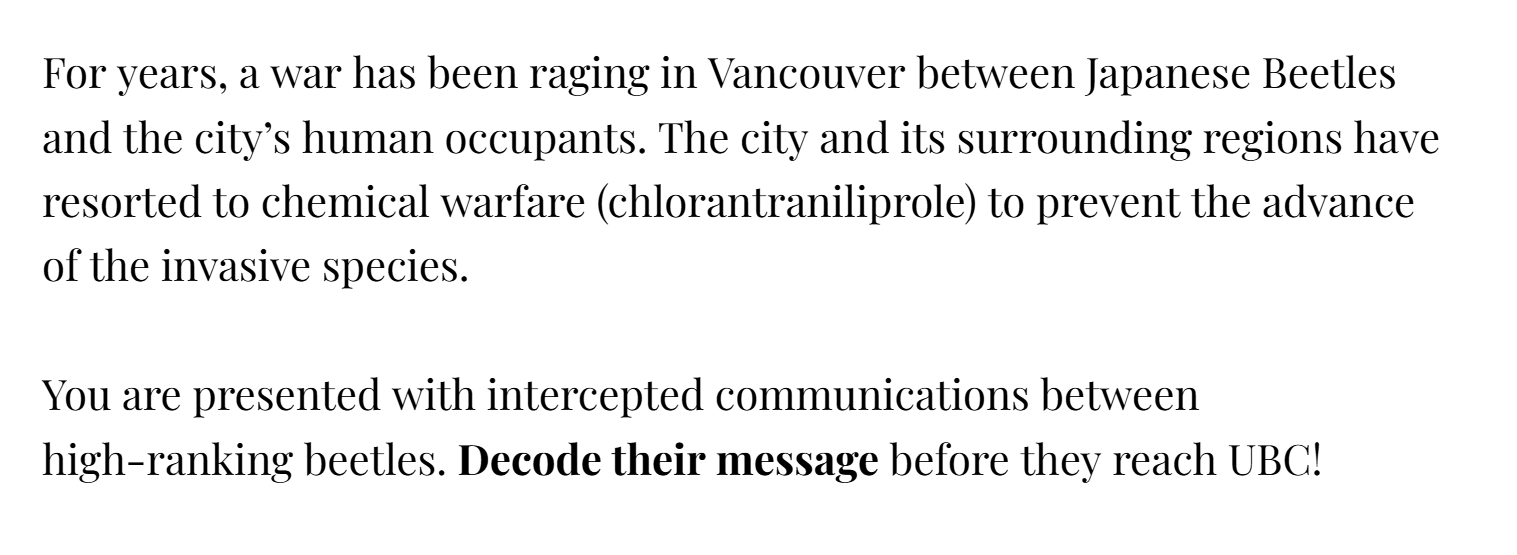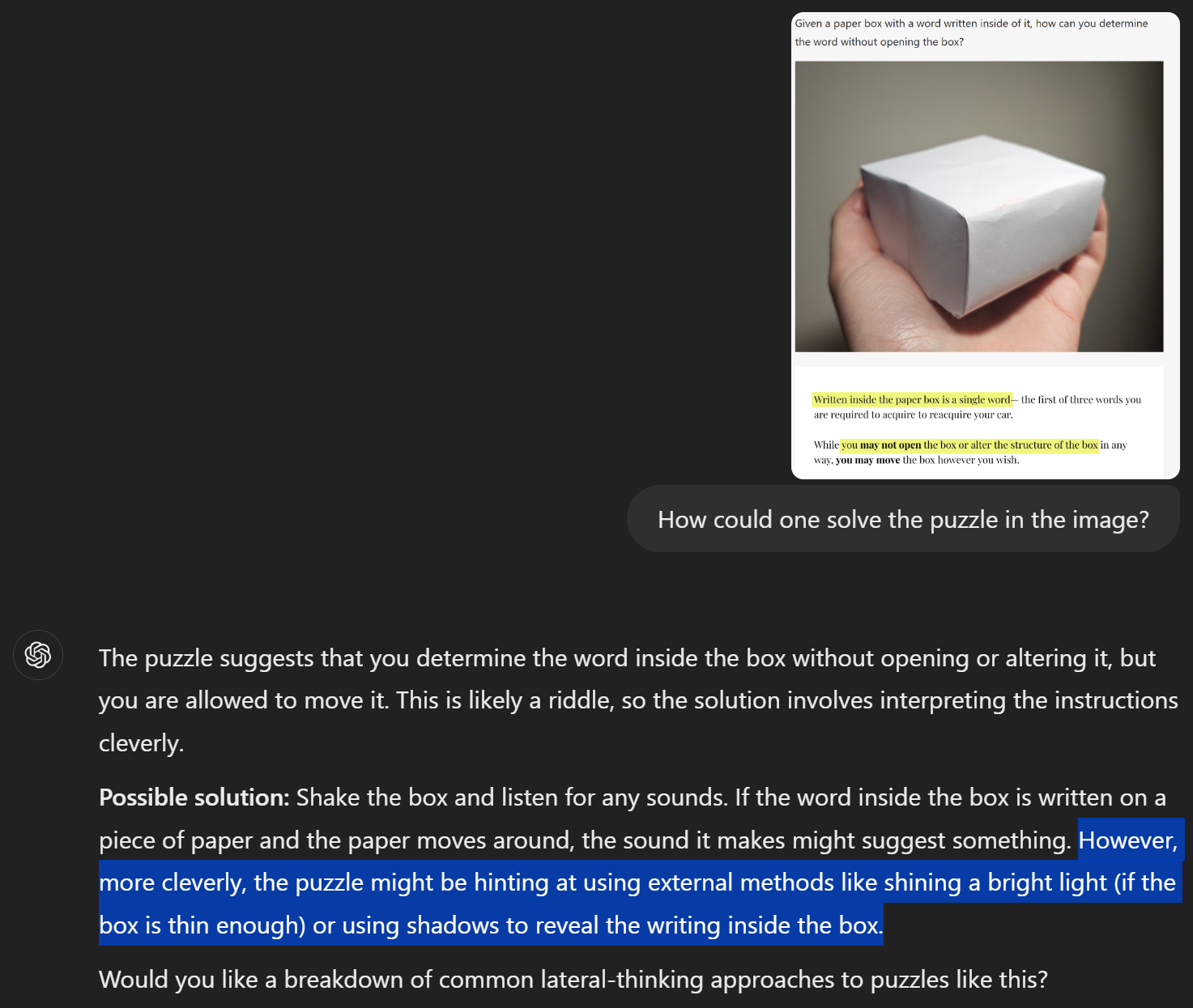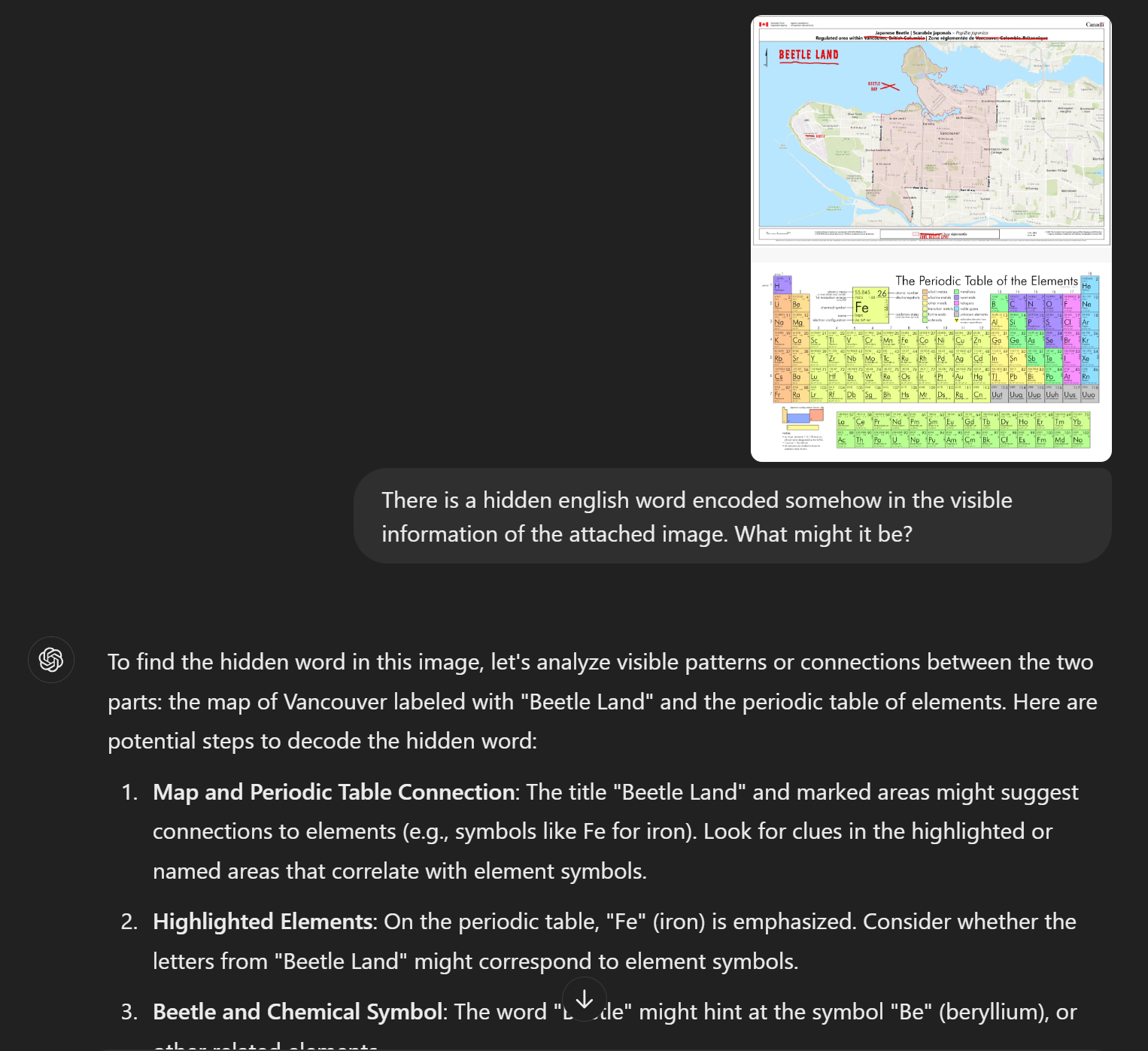A couple weekends ago V2 hosted ‘Side Quest’, an event for people across science, tech, and art to build something with the potential to improve Vancouver. It was great and people made very cool things! Aside from the main build-a-thon the event was centered around, there were also “Mini Quests”– side activities for participants to have fun while taking a break from working. As a volunteer, I put together a short scavenger hunt Mini Quest. Watching people figure things out revealed some interesting tidbits about puzzle-design.
Going into the creation process there were a few high-level goals:
- Be fun and not too frustrating
- ~20-30 minutes expected completion time
- Take the player's mind off of their main project for a bit, while keeping them in a problem-solving mindset
- Relate the quest back to UBC and scientific concepts
- Build off of widely-held scientific intuition without assuming much technical knowledge
- Allow for both individuals and small groups to participate
Or in short, I wanted to get people to solve a few fun science-y puzzles scattered around the beautiful venue. To tie it back to UBC (all mini quests were meant to be themed around certain areas of Vancouver), I also wanted a relevant storyline.
When thinking of a fitting story I could use from UBC's history, I remembered a conversation I had with some cool people (Kai and Rae) back in September. One of them had mentioned that UBC engineering students had managed to put a car on top of a clocktower on campus. How did they do did this? I still have no clue. But it did actually happen! This formed the basis of the ‘story’ I decided upon.
Also, thanks to Stuti for help with the set-up, fonts, and letting me bounce ideas around!
0. Ignition

We've stolen your car! If you ever want to see it again, solve our puzzles – Evil Science Students Organization (ESSO)
While people did typically read the intro paper, it was of course more fun to present it theatrically. The general idea is that the player must solve 3 puzzles (which can technically be done in any order) to obtain a 3 word phrase. This phrase can then be exchanged for the safe return of the car.
To get somewhat close to the 30 minute goal, I knew I wanted to do 3 relatively simple puzzles. Still, there was the question of how to get people to the different puzzle locations. If all puzzles were in one place, everyone at different stages would be bunched together. And of course there's also the fact that this is meant to be a scavenger hunt! People should have to search for things! So 3 setups were created around the floor, with the player having to explore around to find them.
Still, I thought there probably should be some level of guidance to get to the first puzzle. Maybe it would be interesting to do something with mirrors. While I couldn't get a full puzzle working off of the general idea of ‘mirrors’ in the 2 days I had to work on this thing, I did have an idea. Using a setup of multiple mirrors reflecting towards a certain point, a player could move their head around at the initial mirror until they see something. In this case, that ‘something’ would be a sign indicating the location of the first puzzle.

I promise if you zoom in on the red circle you can see the sign!
This took a lot of trouble shooting to set up such that it would work for people of varying heights… and as you might expect people could ‘bypass’ it just by randomly walking down the hall and turning left. It was still cool to see people successfully go the proper route though, and given some more time + mirrors it could be much more expansive.
1. Bright Ideas
Given a paper box with a word written inside of it, how can you determine the word without opening the box?


There's no word-trickery involved here, I literally typed text on google docs, printed the paper, and folded a box. The key concept to recognize here is translucency. Paper is not fully opaque– it lets some light through. However, the ink printed on the paper blocks more light. So by holding the box up to one of the many nearby lamps at the location, you can read the word “BLISSFULLY” (backwards). This puzzle was typically either completed extremely quickly or required many hints. Based on discussions with a small sample of people, it was usually solved based on intuition of how paper ‘works’, and not necessarily an understanding of how light interacts with materials.

2. Invasive Japanese Beetles
By wandering down the hall players would eventually come across the second puzzle. If you've walked around Vancouver at all, you're probably familiar with the ongoing war between the city and invasive japanese beetles.


The player was presented with 2 printed images: a map, and a periodic table.


There are 2 ‘realizations’ needed to solve this:
- the map has been modified
- numbers can map to letters on the periodic table
With realization (1), the intention was for players to notice that certain street names were out of place. For instance, “W 20th Ave is way too high up! W 3rd Ave has been replaced!” This was the case for 20th Ave (1), 37th Ave (2), 8th Ave (3) and 7th Ave (4). These numbers then correspond to certain elements: Ca Rb O N -> Carbon (the second word, and also an element!).

I'll be the first to admit this one isn't particularly clever, and the idea of using numbers to represent words through the periodic table has been done to death. More than that, no one (that I talked to) noticed that certain streets were out of place, they solved it just by seeing that some streets had numbers in parentheses next to them. Typically people overcomplicated this puzzle and spent way longer on it than I intended. This was simply a case of poor design on my part– there are too many things going on between the map and periodic table and there's a million places to potentially ‘hide’ a word. The presentation also didn't lend itself well towards groups working on it. The text is fairly small, so people would have to be bunched around the paper struggling to read.
Maybe most importantly, the element of physicality that makes things fun was missing. Instead of a box to play around with there's just a lot of text. Ultimately, it was challenging for the wrong reasons.
All that said, it was still fun to make a map of BEETLE LAND.
3. Final Scramble
Further down the hall and around a corner, the last puzzle could be found.
The prompt only really makes sense once you've finished the challenge or if you have strong knowledge of Insane Clown Posse's discography.
In person it's easy to tell what's going on here instantly, but it's impossible to figure it out visually. Glued onto the bottom of a bunch of Scrabble pieces are magnets, and there's an array of 5 magnets underlined on a board.
Side note: Scrabble pieces are glossy and don't like krazy glue! I never thought I'd find myself sanding down the bottoms of little wooden letters at 11PM on a Friday night, but that's the position I ended up finding myself in.

The core idea here was polarity. Magnets have a positive side and a negative side; like poles repel and opposite poles attract. On 5 of the scrabble pieces, the magnets are oriented such that they'll be attracted to the 5 magnets in the array on the board. The other magnets are repelled, and the player is unable to place them in an underlined slot. There are a couple clever ways you can solve this once you realize the trick with polarity (e.g., if you have one ‘correct’ letter, it will stack cleanly with the other ‘correct’ letters). But by far the most common approach was simply trying every piece one by one. If there's an obvious but suboptimal way to do something, people will do it.
While this is quite simple, there are a lot of ways you could expand upon this general idea. Magnetic ‘grids’, 3-dimensions, make-shift circuits, etc.
Once you have all 5 correct pieces, you're left with an anagram. The 5 letters were ‘Z’, ‘C’, ‘R’, ‘Y’, ‘A’, for which there is only 1 (English) solution: “CRAZY”.

Maybe the prompt makes a tad more sense now. ‘Insane’ is a synonym of ‘Crazy’, and in 2009 Insane Clown Posse released a song ‘Miracles’ with the lyric “Fucking magnets, how do they work?” which became a meme pretty quickly.
This puzzle was solved by far the most quickly on average out of the 3. It's interesting to me that intuition about magnets seemed to be stronger than intuition about how light interacts with objects (puzzle 1).
4. Blissfully Carbon Crazy
Now with all 3 words, players could tell me the phrase in exchange for their car!

If you're this down far on the page I hope you enjoyed the read :) I had a great time putting this whole thing together, and it really made me happy seeing people have that “OHHHHH” moment, or chuckle at a joke I wrote into the prompts.
Over the past couple years I've mainly been working on more ‘serious’ things– it's always nice to make something purely for fun.
External Assets:
japanese beetle regulated area sign: https://www.countrylifeinbc.com/japanese-beetle-fight-continues/
original japanese beetle regulated area map: https://vancouver.ca/images/cov/content/japanese-beetle-regulated-area.jpg
periodic table: https://commons.wikimedia.org/wiki/File:Periodic_table_large.png
Secret Part 2… How does GPT 4o do?
Nov 26th, 2024
I got curious about something today: how would LLMs do against these puzzles? None of them are using novel scientific concepts, so theoretically they should be able to figure them out. Let's see.
Note: I'm using 4o and not o1-preview since at the time of writing o1-preview doesn't support file uploads.

It got it! Also, I didn't even include the puzzle name ‘Bright Ideas’ in the image I supplied. When the puzzle name is present, GPT 4o doesn't think to use it as a hint and the result stays the same.
Let's see #2. I don't expect this one to be as simple for ChatGPT since there's a lot more useless information and multiple steps are involved.

After about 15 minutes of hinting and trying to get it closer, it can't find the solution. After explicitly asking “Are any numbered streets out of place?” it did notice 37th Ave, but that's the furthest 4o got.
The last puzzle is an interesting case, the main way to solve it is through physically feeling the feedback the pieces give you to understand that you're working with magnets.

Expectedly (but still, impressively), GPT 4o gets the magnets hint in the prompt! No human player got this reference. It then goes on to say “if magnets are involved, they might guide how to place the tiles”. With a little more context, it gets (what I'm counting as) a solve.

While it's not like these puzzles were made with the intention of being difficult, it's still pretty interesting that an LLM can guide towards the solution so effectively.
How do you avoid people ‘cheating’ with ChatGPT then? Make more-novel puzzles :)

